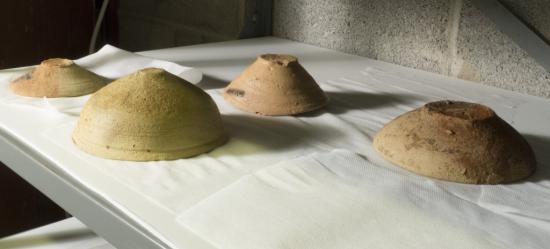Tessa de Alarcon / Penn Museum
In July, I joined the Ur Digitization Project. As a part of this project, I have been working on a condition assessment of the ceramics from Ur. In doing the condition assessment I am looking at, measuring, and evaluating the stability of every ceramic vessel in the Museum’s collection from Ur. So far I have examined over half of the ceramics, and found that the main issue is soluble salts. I know when we all hear salt we think table salt. This is not too far off as table salt, or sodium chloride, is a soluble salt. This just means that the salt is soluble in water and in many cases is also hygroscopic (a big word for “absorbs moisture from the air”). We have all seen how salt clumps in salt shakers and won’t shake out nicely when it’s humid. This happens because the salt is hygroscopic.

The salt in this shaker has clumped because the salt is hygroscopic
You are probably wondering “Why this is a problem for ceramics?” Archaeological ceramics can absorb salts through moisture in the burial environment, and once they are excavated and dry out, the salts crystallize. If they crystallize inside the pores of the ceramic they can cause damage. If the ceramic is then exposed to changing relative humidity, these salts can go through cycles of dissolution as they pull moisture from the air and re-crystallization when they dry out, causing even more damage over time.

The pot on the left shows spalling. This happens when the salts pop off circular patches of the surface. You can see a spalled area in the front with the white salt crystals in the middle. The pot on the right is delaminating. This is also caused by the crystallization of salts. In this case they crystallize in a single plane, pushing off thin layers of the ceramic.
To stabilize the salty pots from Ur, I have been working on setting up a desalination station. This involves setting up an area where the pots can be safely soaked. Because these salts are soluble, they can be removed by soaking the object in water. The images below walk through the process I have been using to stabilize objects like the ones shown above.

Consolidation of a ceramic from Ur
Because the surfaces of the ceramics are so unstable, these objects have to be consolidated first with a dilute adhesive that is not soluble in water (otherwise the consolidant would be removed during desalination along with the salts). I have been using Paraloid B-72™ in acetone that I apply drop-wise so that I can control where it goes and how much is applied.

Ceramic vessels soaking in deionized water
After the pots are consolidated and the adhesive has fully dried (I usually wait a few days after consolidation to be sure), each object is weighed and placed in a known volume of deionized water. The pots are weighed and the water measured so that I can calculate when they are ready to come out of the water and compare the data from pot to pot.

Checking the conductivity of the water during desalination
I use a conductivity meter to record how much salt is being extracted from each object. Every time I take a reading, I note the date and time as well so that I can plot the data on a graph. The length of time each pot soaks depends on various factors (weight, volume of water, how salty it is), but to give you an idea, they can stay in the water for a week or more. Once each pot has been desalinated I pull it out of the water, rinse it off, and let it dry.

Ceramics drying after desalination
If the surface is unstable after the pot has dried, I do some final consolidation. Once the treatment is complete, I take the final treatment pictures and the pot goes back to its home in storage.